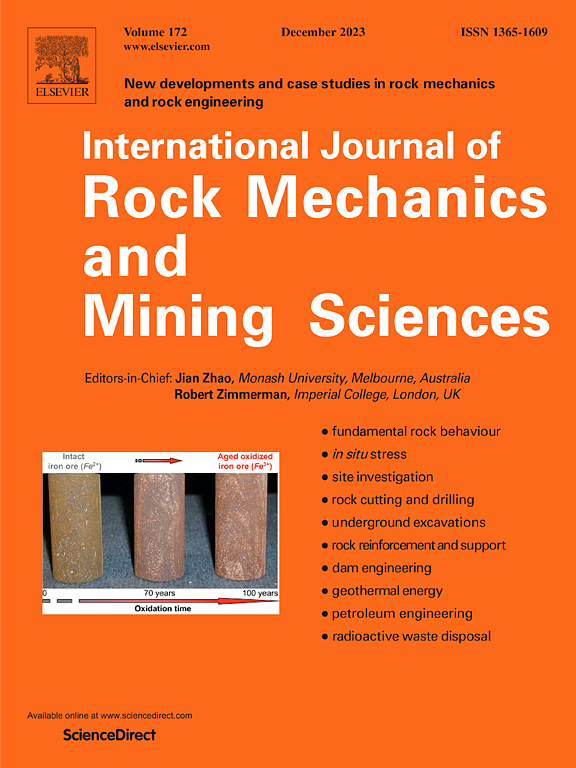Inferring fracture dilation and shear slip from surface deformation utilising trained surrogate models
IF 7.5
1区 工程技术
Q1 ENGINEERING, GEOLOGICAL
International Journal of Rock Mechanics and Mining Sciences
Pub Date : 2025-03-01
DOI:10.1016/j.ijrmms.2025.106077
引用次数: 0
Abstract
An important task in energy and CO2 storage (sequestration) in the subsurface is to verify that the surrounding fractures and faults are not activated, acting as leakage pathways. This is achievable through effective and efficient Measurement, Monitoring and Verification (MMV) plans. In this work, two surrogate models are trained to captures dilation (opening) and shear deformation of fractures, and the associated surface deformation. The trained surrogate model, based on conditional Generative-Adversarial Networks (cGAN) receives fracture apertures from dilational fractures together with fracture slips from shear fractures and predicts the combined surface deformation. An inversion algorithm based on Bayesian framework is proposed to identify the geometry of both types of fractures, as well as volume of dilational fractures and deformation moment induced by shear fractures, all from the measured surface deformation data. The inversion algorithm utilises the Differential Evolution (DE) optimisation technique that has the superior performance in finding the global minimum of cost function. The proposed surrogate-assisted inversion successfully inferred the unknown dip, dip direction and the volume of the dilational fractures as well as the induced deformation moment in shear fractures. The model was further tested for the inversion of a field hydraulic fracturing tilt dataset applying different scenarios with varying unknowns to show the model's performance, as well as incorporating shear deformation for better match with the observed data.
利用经过训练的代理模型从表面变形推断裂缝扩张和剪切滑移
地下能量和二氧化碳储存(封存)的一项重要任务是验证周围的裂缝和断层没有被激活,它们是泄漏通道。这可以通过有效和高效的测量、监测和验证(MMV)计划来实现。在这项工作中,训练了两个代理模型来捕获裂缝的扩张(打开)和剪切变形,以及相关的表面变形。基于条件生成对抗网络(cGAN)的训练代理模型接收来自扩张裂缝的裂缝孔径以及来自剪切裂缝的裂缝滑移,并预测综合地表变形。提出了一种基于贝叶斯框架的反演算法,从实测地表变形数据中识别两类裂缝的几何形状、扩张裂缝的体积和剪切裂缝引起的变形矩。该算法利用微分进化优化技术,在寻找成本函数的全局最小值方面具有优越的性能。该方法成功地推导出了张性裂缝的未知倾角、倾角方向和体积,以及剪切裂缝的诱导变形矩。为了更好地与观测数据匹配,我们对该模型进行了进一步的测试,应用不同的未知场景对现场水力压裂倾斜数据集进行了反演,以展示模型的性能,并将剪切变形纳入其中。
本文章由计算机程序翻译,如有差异,请以英文原文为准。
求助全文
约1分钟内获得全文
求助全文
来源期刊
CiteScore
14.00
自引率
5.60%
发文量
196
审稿时长
18 weeks
期刊介绍:
The International Journal of Rock Mechanics and Mining Sciences focuses on original research, new developments, site measurements, and case studies within the fields of rock mechanics and rock engineering. Serving as an international platform, it showcases high-quality papers addressing rock mechanics and the application of its principles and techniques in mining and civil engineering projects situated on or within rock masses. These projects encompass a wide range, including slopes, open-pit mines, quarries, shafts, tunnels, caverns, underground mines, metro systems, dams, hydro-electric stations, geothermal energy, petroleum engineering, and radioactive waste disposal. The journal welcomes submissions on various topics, with particular interest in theoretical advancements, analytical and numerical methods, rock testing, site investigation, and case studies.

 求助内容:
求助内容: 应助结果提醒方式:
应助结果提醒方式:


